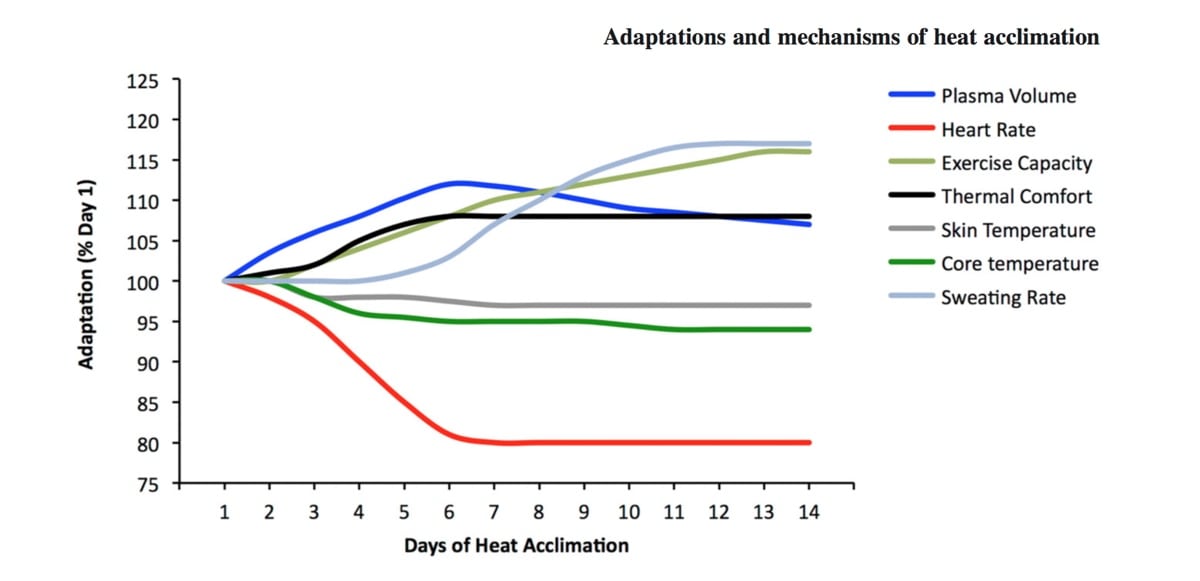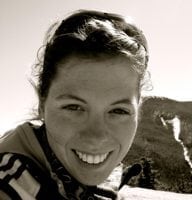As a runner and a coach of runners, I don’t know how many times every summer I hear, “I just don’t do well in the heat” or similar defeating statements before we even reach the start line of the race or the trailhead for our run. There’s some truth in the statement; running in the heat is physiologically complicated, and can be just plain hard. However, we are fortunate enough to have bodies that adapt at extraordinary rates to our surroundings to not only survive but thrive in a wide variety of extreme environments. In this article, we talk about how our bodies handle thermoregulation (the body’s ability to self-regulate temperature), heat acclimation (the body’s ability to adjust to the effects of heat over time), and the tools you can use to prepare for future hot-weather runs and races.
What should you know right now? Exercising in the heat is taxing, heat acclimation cannot only prepare you for running in the heat but make you better at running in the cold, there is more than one way to effectively get the business end of heat training done, and you should commit seven to 10 consecutive days to the adaptation process. Read on to learn more!
As humans, we are homeothermic endotherms. This means we are an animal that maintains a relatively constant body temperature (homeotherm) and we do so by primarily producing our own heat via metabolic processes (endotherm). When it comes to thermoregulation, we rely on our body’s internal capabilities to maintain our body’s ideal core body temperature. Even with these ways of regulation, the combination of heat stress from the environment and exercise (which creates more heat) can act in tandem to not only hurt athletic performance but also cause serious heat illnesses (1).
When exercising, you increase your metabolic heat production, or the heat your body produces, by three to 12 fold above your normal resting rate. Then, when you add environmental heat to that mix, the heat strain placed on the body can send your endurance performance into a downward spiral. In fact, independent of heat acclimation, extreme heat stress can lower your VO2max during exercise and keep you from running at a “maximal aerobic level.” These reductions in VO2max have shown to generally be proportionate to an increase in skin temperature (1), and we know that a decrease in VO2max physiologically means a decrease in performance. Looking at marathon performances ranging in temperatures from 50 to 75 degrees Fahrenheit, even then they saw an average decrease of 2% (two to three minutes) in elite competitors and as much as 10% (18 minutes) in three-hour marathon finishers (23). So how does this happen?
The Basics of Thermoregulation
To understand thermoregulation as it specifically pertains to heat acclimation, it’s important to understand how our bodies both conserve and dissipate heat and how the environment acts on the body. When it comes to conserving heat, our bodies shiver to create metabolic energy and thus warmth, and utilize vasoconstriction, the shrinking of blood vessels, to shunt blood toward our core, which protects our major organs and keeps blood flowing from our heart and lungs and to our brain.
When it comes to dissipating heat, our blood vessels can do the opposite and vasodilate, or expand, sending more blood to the surface of our skin so that it can leave the body. Additionally, we can utilize sweating and evaporation as long as the humidity of the environment is low enough. This is because in order for your sweat (or other water on the skin, think pouring cold water on racers at hot-weather races) to evaporate, the air has to have a lower concentration of water molecules (lower humidity) to accept the transfer of water via water vapor from your skin. Interestingly enough, heat loss through the evaporation of sweat (or other liquids we put on the surface of our skin) is one of the most effective ways we can cool our bodies, which is why hot, humid environments are even more challenging to race and train in (1)!
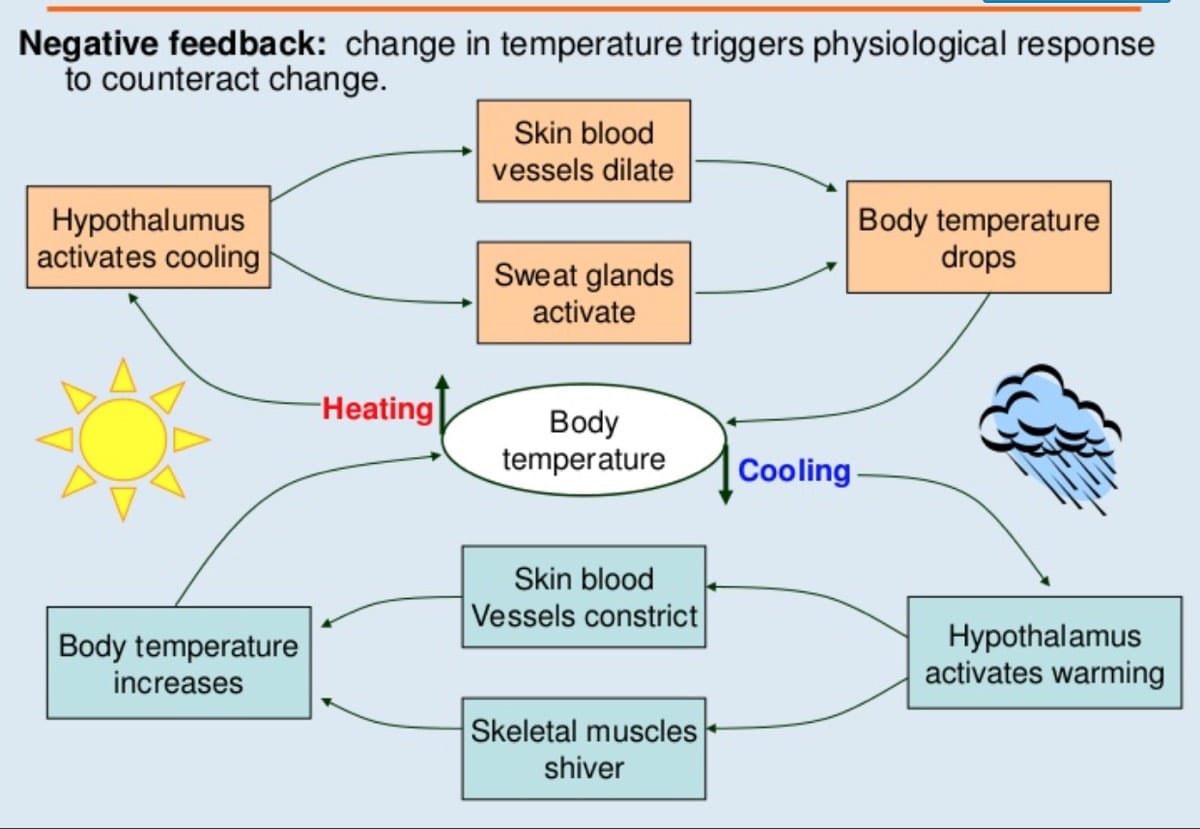
Thermoregulation and metabolic heat exchange in humans. Think of your hypothalamus as your brain’s thermostat. It gets the signals that say “I’m cold” or “I’m hot” and activates things like sweating or shivering to try and cool you down or warm you up. Image courtesy https://www.slideshare.net/DrAlana/lec-09-thermoregulation.
The other factor that comes into play with thermoregulation is the influence of the environment. Ambient air temperature can be greatly influenced by the surface on which you run, direct versus indirect sunlight, and even the direction of the wind. The physics of heat transfer that affect thermoregulation can be divided into four categories; conduction, convection, radiation, and evaporation. Conduction is the direct energy transfer between two bodies in contact, like your foot and the hot blacktop. Convection is the movement of water or air over a surface, like the wind blowing air or rain over your skin. Radiation is the emission of energy from another object, like the sun radiating off the ground or other vegetation. And finally, evaporation, or the conversion of liquid to gas, which causes cooling of the surface from which the liquid evaporates (1). All of these components act together to both heat you up and cool you down and it’s in constant flux, dependent largely on a difference in temperature gradient between you and your surrounding environment.
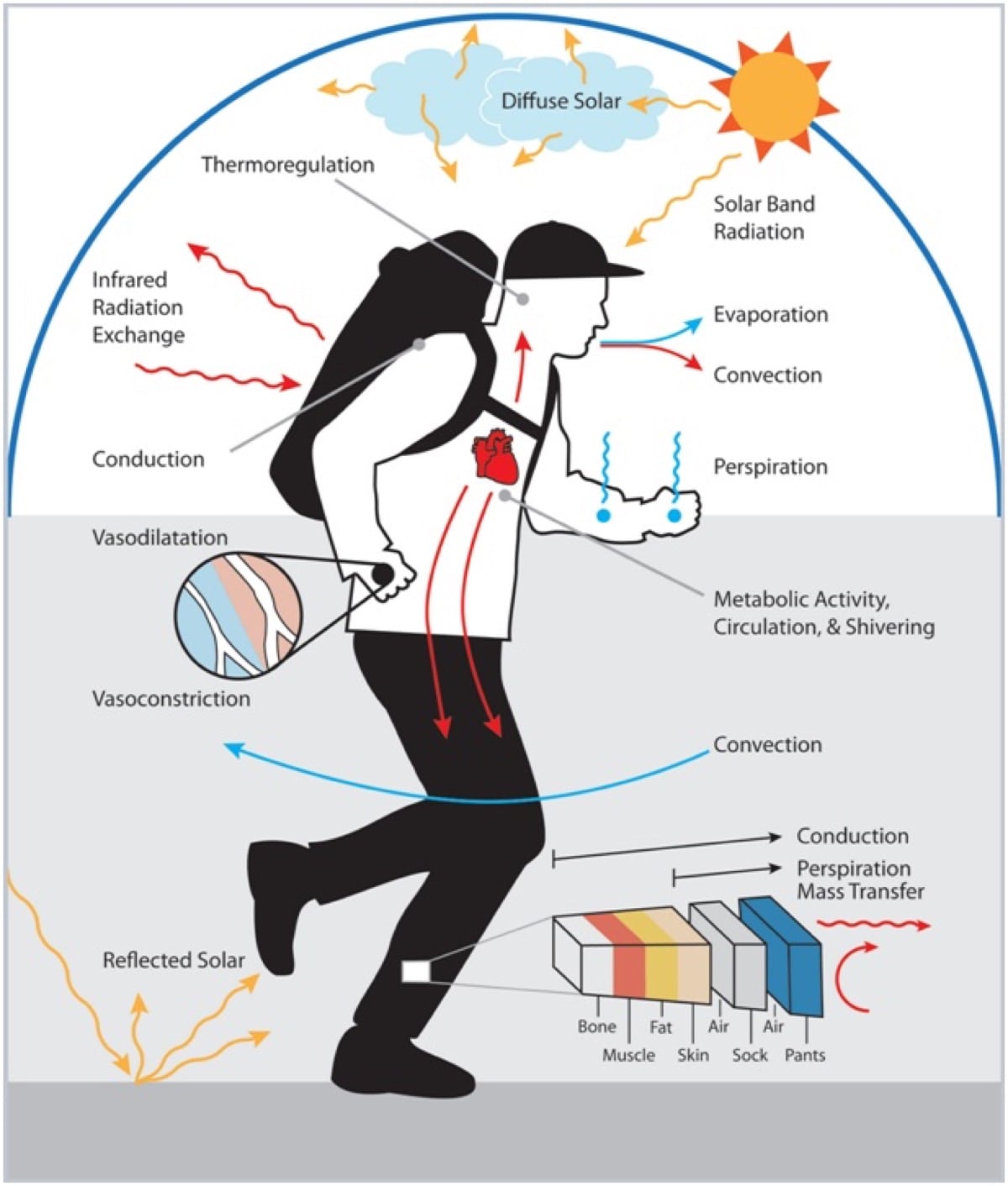
The physics of thermoregulation and heat transfer. Image courtesy https://www.earthslab.com/physiology/thermoregulation-human-body/.
The Basics of Heat Acclimation
Acclimation is the process in which you adjust to changes in your environment over time, which allow you to maintain bodily functions and performance across a wide range of environmental conditions. In the case of heat acclimation, your body is making endogenous, internal, changes to better function in hot environments. Key changes that your body makes with chronic, daily, heat exposure are: an increase in sweat rate and decrease in sweat electrolyte concentration, blood plasma volume expansion, lower skin and core temperatures, lower heart rate during exercise, increased fluid and cardiovascular stability, and a decrease in the metabolic cost of work (exercise) (2, 3). These factors, in combination with one another, provide maybe the greatest adaptations of all, an improvement in our ability to tolerate and feel more comfortable in the heat during exercise (3).
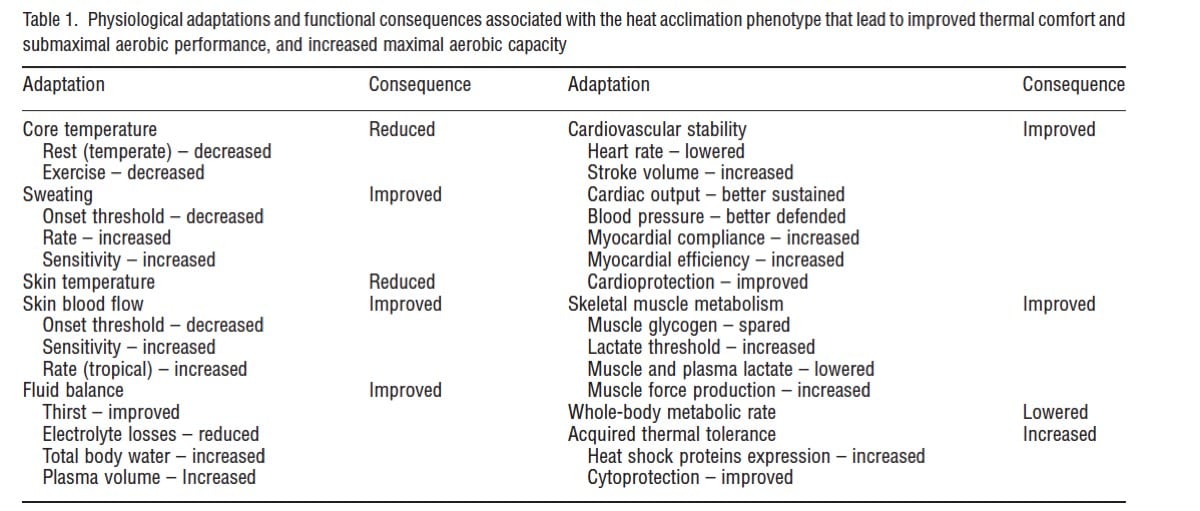
The multifactorial variables that contribute to heat acclimation and improved thermal comfort during exercise (3).
Sweating
Changes in your sweat rate and the composition of your sweat were some of the earliest physiological changes noted and explored when it came to research studying heat acclimation. Not only do you start to sweat earlier, at a lower skin and core body temperature (thanks hypothalamus), but you also have an increased sweat rate (in liters per hour) and more dilute sweat as your body loses fewer electrolytes like sodium and chloride per liter of sweat (3). Peripherally these changes occur at the level of the sweat gland as your eccrine glands produce sweat more efficiently and for a more sustained length of time. Interestingly enough, since you are losing fewer electrolytes per liter of sweat, you actually become better at utilizing evaporative heat loss. This is because a more dilute solution will evaporate more quickly, which means you get to benefit from cooling happening more quickly.
As mentioned earlier, evaporative heat loss is one of the most prominent tools of heat dissipation we have at our disposal, making this adaptation extra important. For the longest time I thought this all happened because our bodies must be capturing, holding onto, or reabsorbing all those electrolytes more efficiently, when in actuality that is more or less held constant as our sweat rate (liters/hour) does the changing.
Cardiovascular Stability (Heart-Rate Control and Aerobic Demands)
You might notice on your first hot run of the year that your level of exertion seems way too high. You think to yourself, Running should not be this hard! Your heart rate is higher than it would be for the pace or workload at cooler temperatures. It’s uncomfortable, but it’s normal. This is due to the increased cardiac strain in the heat, and over the course of a week of running in hot temperatures your heart rate will begin to return to more normal values.
There are a number of things responsible for reducing cardiac strain: blood plasma volume expansion, improved skin cooling due to better redistribution of your blood volume, and increased venous tone (dilation) (3). As you heat acclimate and you have more blood flow away from your core and toward your skin and extremities, your body can dissipate more heat into the environment. This is particularly true if the air temperature is cooler than your core body temperature.
The other key component of cardiovascular stability is blood plasma volume expansion. Blood plasma, which normally makes up 55% of your blood volume, helps to carry not only red blood cells (held in suspension) but also helps to carry and transport nutrients, hormones, and other proteins. The result of an increase in plasma volume (and its carrying capacity) is an increase in cardiac output, or rather, the amount of blood the heart can pump through the circulatory system in one minute. This mathematically is simple: cardiac output = heart rate x stroke volume. The result is a higher VO2max at any given effort level. Studies show that with seven to 10 days of heat acclimation, resting blood plasma volume can expand anywhere from 4.5 to 13% (5,6,7,8).
Fluid Balance
Another physiological phenomenon that occurs during heat acclimation is fluid balance. Specifically, our bodies become better (albeit slightly) at matching our water needs with our thirst as well as producing more dilute sweat, and once again blood volume increases. Call it a survival mechanism, but being slightly more in tune with your hydration needs is beneficial as you become heat acclimated and your sweat rate per hour can increase 50 to 100% above your baseline (which on average is 0.7 to 1 liters/hour) (1).
Thermal Tolerance
The thermal tolerance component of heat acclimation is not quite what it seems. Thermal tolerance refers to cellular adaptation to what would otherwise be lethal heat exposure. On a cellular level, heat shock proteins (HSP) are activated, and in the case of heat stress and exercise it’s specifically HSP72 and HSP90. Activated HSPs bind to denatured, altered proteins and thus protect your body from extreme heat, hypoxia, viral infections, acidosis, and ischemia (inadequate blood supply) (9). I’ve heard HSPs referred to as “chaperones,” as they guard and guide other cellular proteins from straying or assembling incorrectly (21). Essentially HSPs help keep ‘order’ while our bodies undergo numerous, sometimes messy cellular adaptations to environmental stressors like heat.
In studies looking at heat-acclimated rats, those that had undergone complete thermal tolerance via heat acclimation (six to 10 days of exposure) could tolerate 60% more thermal load, or heat stress, than their non-acclimatized counterparts (10). Essentially, this microscopic change occurring during heat exposure is one of our body’s greatest environmental adaptations. We are just starting to do more research on HSP as well as a host of other genetic variables and how they influence the human body. Some of the most interesting research coming out (in my opinion) as it pertains to athletes is how heat acclimation and HSPs affect altitude acclimation, but that is a story for next month’s ‘Running on Science’ column, so stay tuned.
Thermal Comfort
If thermal tolerance is not quite what it sounds like, thermal comfort, on the other hand, is exactly what it sounds like. A key coming together of all the above adaptations is the fact that, perceptually, the heat starts to feel well, not as hot. As shown in the chart below, thermal comfort is generally gained by day five of heat acclimation (3). Generally speaking, in both exercise-physiology research and environmental-physiology research (think apparel testing for companies), people are asked to rank their comfort on a scale. In that sense, thermal comfort is an entirely subjective measure. So it’s given that the more exposure you have to anything will make you more comfortable with it, you also have some psychological influence over yourself. Choose to embrace it.
Time Required to Gain and Lose Heat Acclimation
Looking back at the big picture, when it’s all said and done, it takes seven to 10 days to make complete adaptations with 75% of the adaptations taking place in just the first four to six days of the heat-acclimation process (4).
There is also some debate on how long it takes to loose these changes, or what researchers like to call “heat-acclimation decay” (3). These suggestions include, on the slow side, that you lose one day of heat acclimation for every five days spent away from the heat, to the fast side, that you lose one day of heat acclimation for every two days spent away from the heat (3). The general consensus, albeit a bit shaky, is that after 48 hours without heat exposure, you lose 2.5% of your adaptations on each additional day thereafter (12).
While looking over the research, most studies targeting heat acclimation range from four to 27 days in length. In each of these research projects, they’ve been able to see variation in the many metrics shown in the chart below. By doing daily recordings after (or during) each day of heat exposure, there is quite a lot of data following the daily progression of heat acclimation using multiple modalities. Without a doubt there is always going to be individual variation; additionally, there will be some minor variation based on which modality you use.
Methods of Heat Acclimation
Now down to the nitty gritty, how do you get better at running in the heat? How can you jumpstart the heat-acclimation process for your summer running or upcoming warm-weather race? There are several methods to this madness and most have been shown to be effective. However, in performance exercise physiology, what we look for is the smallest effective dose that gets results. Now why isn’t more always better? You have to balance heat acclimation with the rest of your training. Just like a bump in weekly volume or additional intensity work, heat acclimation is extra stress on the body. Therefore, depending on how you choose to go about heat acclimating, you will likely have to sacrifice the quantity and/or quality of your workouts during this time.
What we know is that in repeatedly increasing your core body temperature via exercise, environmental means, passive interventions, or all of the above, you induce the physiological adaptations that are associated with greater thermal comfort (11).
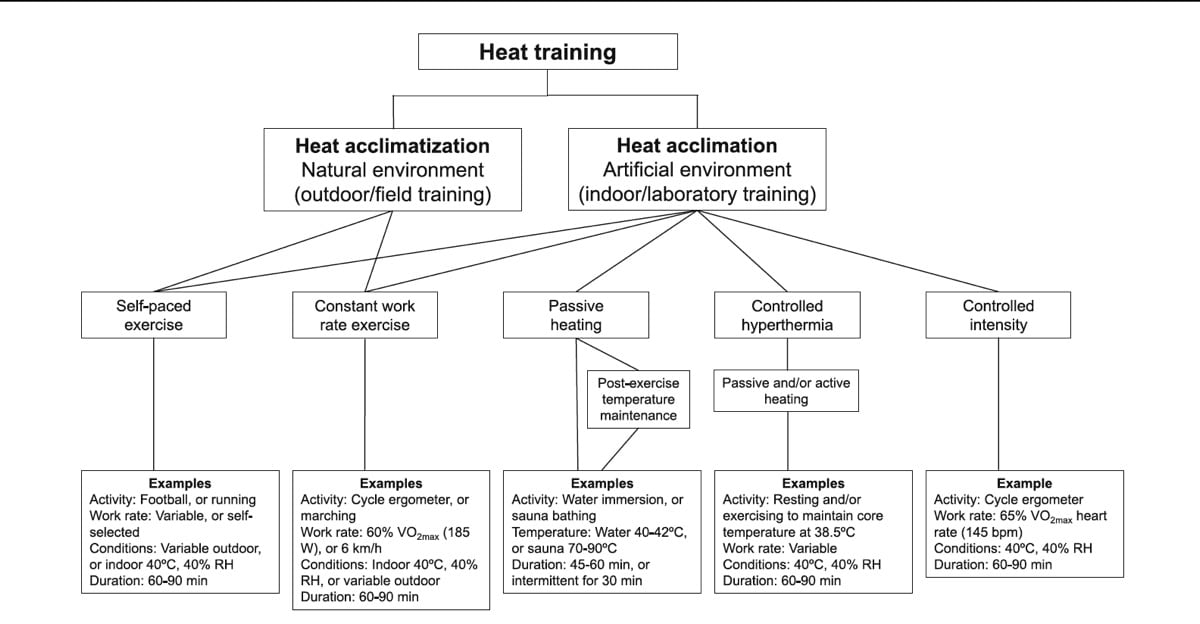
Multiple effective heat-acclimation modalities including activity, duration, and temperature recommendations (12).
Duration and Number of Sessions
When it comes to how long heat-acclimation sessions should be and how many sessions are needed to get results, there is research to support just about any methodology. The key once again is wisely choosing how to get that dose while not inhibiting your training or tapering.
There have been numerous studies dating back to the 1960s that look at 50-to-100-minute daily heat exposures (4,14), twice daily heat exposures (13), active acclimatization via exercising in warm weather or by piling on extra clothes (15), passive sauna heat exposures (20), and in trials lasting anywhere from five to 27 days (8, 16, 17, 18). From a review of the literature, we know that exercising at 60% of VO2max in the heat (39 degrees Celsius) produces the quickest results, and using solely passive heat exposure the slowest. Despite that, the general recommendation is still six to 10 consecutive days. We also know that once-daily doses are as or more effective than twice-a-day doses (12). But, once again, how much is enough? How little allows you to maintain your normal training, tapering, and your daily routine?
In the past couple of years, a new heat-acclimation protocol has emerged in athletic and research circles. A best-of-both-worlds, hybrid approach. A combination of active and passive heat acclimation that is so far showing signs of being as effective (six consecutive days of exposure needed) as the longer, more taxing, and more traditional heat-acclimation approaches (19, 21). I like to call this ‘two birds one stone,’ as you can get your planned workout in followed by passive heat exposure. When you exercise, you naturally increase your skin and core body temperature (even in cooler climates), and by jumping into the sauna post-exercise, you can capitalize on your core body temperature already being elevated and prolong that state with the added heat. Suddenly you just cut the recommendation of 100 minutes of intense heat exposure down to a much shorter amount of time and you can acquire all the same adaptations as a longer sweat fest.
Performance Implications of Heat Acclimation
Why go through all this trouble? What could you possibly get out of hours of uncomfortable sweating? Aside from becoming better equipped to function and thrive when the mercury rises, there are noted performance benefits of heat acclimation that go beyond being ready to sweat it out. In studies looking at heat-acclimated endurance-trained cyclists post-heat acclimation, measures of VO2max in the cold and heat increased by 5% and 8% respectively, power output at lactate threshold (for runners this would likely be most comparable to running speed at lactate threshold) in the cold and in the heat by 5%, and improved time-trial times in the cold in the heat by 6% and 8% respectively (8). Remember, heat will decrease VO2max regardless of heat acclimation, but heat acclimation can protect you from a bulk of this decrease. Similar values have been reported ranging from four to 10% improvements in VO2max in hot environments, corroborating these findings.
What should this mean to you? Not only does heat acclimation benefit you when it comes to hot runs and races, but very likely aids performance in cooler temperatures as well. Essential heat acclimation should make the hard efforts several percentage points easier. Let’s just say 10% of 24 hours (harkening back to how much heat decreases three-hour marathon-finisher performances) is 144 minutes or roughly 2.4 hours. To me these findings suggest that heat acclimation is probably very worth your weight in sweat.
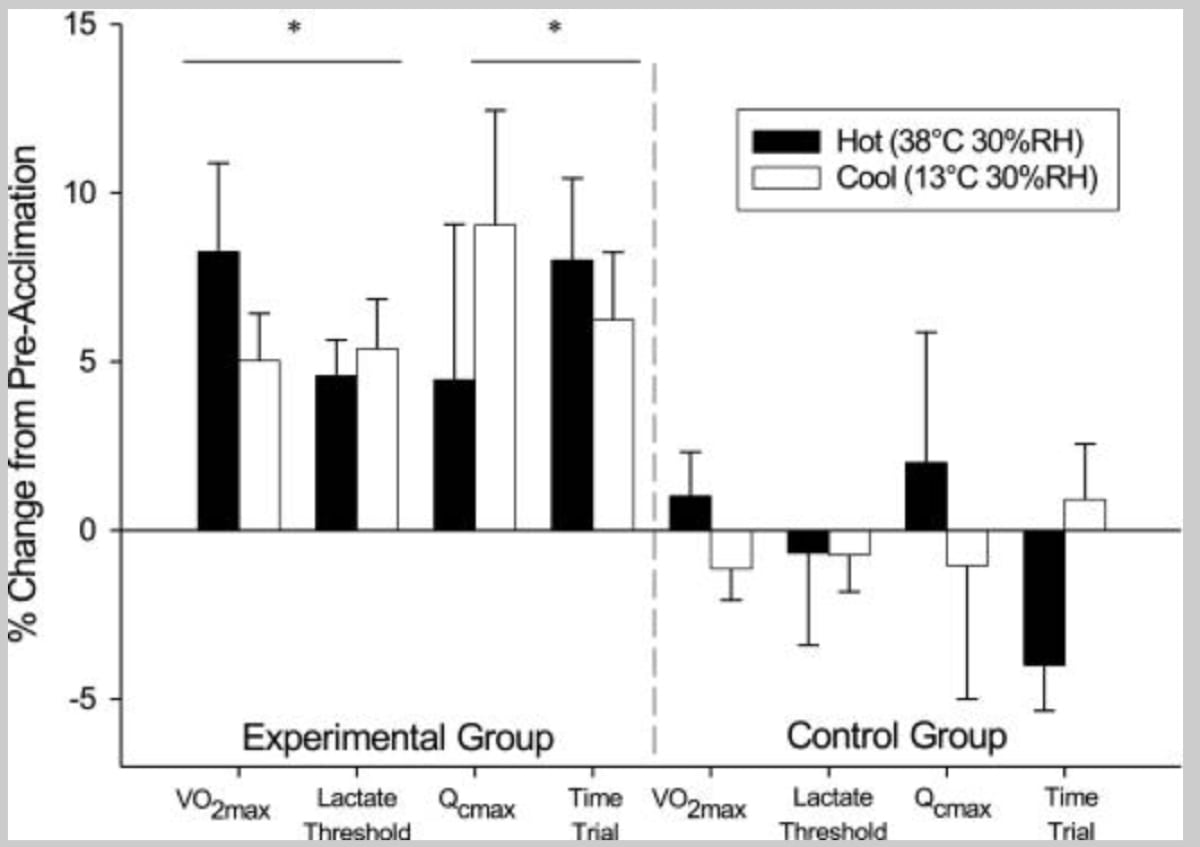
Noted differences between the heat-acclimated group (left) and the control group (right), with the heat-acclimated group improving across the board (VO2max test, lactate-threshold improvement, maximal cardiac output, and time-trial performance) from their pre-acclimation testing (8). This research used endurance-trained cyclists. RH = relative humidity.
How Should I Heat Acclimate?
Dosage
Six to 10 daily doses of heat acclimation is the money zone of making the necessary physiological adaptations. Use the chart above showing different heat-acclimation modalities including activity, duration, and temperature recommendations to adapt the protocol to the method you’ll use, and consider the previously described hybrid adaptation approach.
Once you make it through six to 10 days in a row, you can opt to get your heat fix once every three days to get enough stimulus to maintain your heat adaptation benefits. You lose approximately 2.5% of your gained adaptations each day after the 48-hour window of non-exposure (12).
Total Load
Evaluate the reason for your heat acclimation. Are you prepping for a race? Is this during your final race prep and taper? Think big picture and make sure you don’t create too much stress at an inopportune time. I recommend starting two weeks to 16 days out from your event so that you do not inhibit your recovery and taper leading into your big race. You can do maintenance sessions in your final week pre-race like I suggest above. This keeps the adaptations close to your goal event without adding too much stress to the body.
Use What You Have
Not everyone has access to a sauna or hot tub, and not everyone lives in a place (or season) that gets particularly warm. Utilize the tools you have available. Science shows that, while a few methods may allow acclimation to occur more quickly, there are many ways to gain this heat-acclimation edge.
Rehydrate
Although you do not need to be chugging water in the sauna, it is important to end your day back at baseline and in a hydrated state. Being chronically dehydrated can impair your body’s adaptation process (1), and I’m sorry to say it I’m going to have to throw alcohol consumption on this pile as well as it has also been shown to slow the adaptation process, most likely due to too much alcohol countering rehydration. However, don’t panic or write this entire article off, most of the dehydrating effects of alcohol are easily mitigated by additional water intake.
Consult Your Doctor
Heat acclimation, combined with exercise strain, is incredibly hard on the heart and some other internal organs (hello kidneys!). If you have a known cardiac condition, jump starting your heat acclimation by turning up the heat might not be for you, so always consult your primary care provider before engaging in this type of activity.
References
- Sawka, M. N., Leon, L. R., Montain, S. J., & Sonna, L. A. (2011). Integrated Physiological Mechanisms of Exercise Performance, Adaptation, and Maladaptation to Heat Stress. Comprehensive Physiology,1883-1928. doi:10.1002/cphy.c100082
- Rivas, E., Rao, M., Castleberry, T., & Ben-Ezra, V. (2017). The change in metabolic heat production is a primary mediator of heat acclimation in adults. Journal of Thermal Biology,70, 69-79. doi:10.1016/j.jtherbio.2017.10.001
- Périard, J. D., Racinais, S., & Sawka, M. N. (2015). Adaptations and mechanisms of human heat acclimation: Applications for competitive athletes and sports. Scandinavian Journal of Medicine & Science in Sports,25, 20-38. doi:10.1111/sms.12408
- Pandolf, K. (1998). Time Course of Heat Acclimation and its Decay. International Journal of Sports Medicine,19(S 2). doi:10.1055/s-2007-971985
- Nielsen B, Strange S, Christensen NJ,Warberg J, Saltin B. Acute and adaptive responses in humans to exercise in a warm, humid environment. Pflugers Arch 1997: 434: 49–56.
- Nielsen B, Hales JR, Strange S, Christensen NJ, Warberg J, Saltin B. Human circulatory and thermoregulatory adaptations with heat acclimation and exercise in a hot, dry environment. J Physiol 1993: 460: 467–485.
- Garrett, A. T., Creasy, R., Rehrer, N. J., Patterson, M. J., & Cotter, J. D. (2011). Effectiveness of short-term heat acclimation for highly trained athletes. European Journal of Applied Physiology,112(5), 1827-1837. doi:10.1007/s00421-011-2153-3
- Lorenzo, S., Halliwill, J. R., Sawka, M. N., & Minson, C. T. (2010). Heat acclimation improves exercise performance. Journal of Applied Physiology,109(4), 1140-1147. doi:10.1152/japplphysiol.00495.2010
- Kregel KC. Heat shock proteins: modifying factors in physiological stress responses and acquired thermotolerance. J Appl Physiol (1985)2002: 92: 2177–2186.
- Fruth JM, Gisolfi CV. Work-heat tolerance in endurance-trained rats. J Appl Physiol 54: 249-253, 1983.
- Minett, G. M., Skein, M., Bieuzen, F., Stewart, I. B., Borg, D. N., Bach, A. J., & Costello, J. T. (2016). Heat acclimation for protection from exertional heat stress. Cochrane Database of Systematic Reviews. doi:10.1002/14651858.cd012016
- Daanen, H. A., Racinais, S., & Périard, J. D. (2017). Heat Acclimation Decay and Re-Induction: A Systematic Review and Meta-Analysis. Sports Medicine,48(2), 409-430. doi:10.1007/s40279-017-0808-x
- Cheuvront SN, Chinevere TD, Ely BR, et al. Serum S-100beta response to exercise-heat strain before and after acclimation. Med Sci Sports Exerc. 2008;40(8):1477–82.
- Lind AR, Bass DE. Optimal exposure time for development of acclimatization to heat. Fed Proc. 1963;22:704–8.
- Stevens, C. J. (2018). Evidence for training in additional clothing as an alternative heat acclimation strategy for athletes. Temperature,1-2. doi:10.1080/23328940.2018.1437309
- Ely MR, Kenefick RW, Cheuvront SN, et al. The effect of heat acclimation on sweat microminerals: artifact of surface contamination. Int J Sport Nutr Exerc Metab. 2013;23:470–9
- Fein JT, Haymes EM, Buskirk ER. Effects of daily and intermittent exposures on heat acclimation of women. Int J Biometeorol. 1975;19(1):41–52.
- Weller AS, Linnane DM, Jonkman AG, et al. Quantification of the decay and re-induction of heat acclimation in dry-heat following 12 and 26 days without exposure to heat stress. Eur J Appl Physiol. 2007;102(1):57–66.
- Ruddock, A. D., Thompson, S. W., Hudson, S. A., James, C. A., Gibson, O. R., & Mee, J. A. (2016). Combined active and passive heat exposure induced heat acclimation in a soccer referee before 2014 FIFA World Cup. SpringerPlus,5(1). doi:10.1186/s40064-016-2298-y
- Pallubinsky, H., Schellen, L., Kingma, B. R., Dautzenberg, B., Baak, M. A., & Lichtenbelt, W. D. (2017). Thermophysiological adaptations to passive mild heat acclimation. Temperature,4(2), 176-186. doi:10.1080/23328940.2017.1303562
- Roles of Heat Shock Proteins. (2008). Retrieved from https://www.scientificamerican.com/article/roles-of-heat-shock-proteins/
- Stanley, J., Halliday, A., D’Auria, S., Buchheit, M., & Leicht, A. S. (2014). Effect of sauna-based heat acclimation on plasma volume and heart rate variability. European Journal of Applied Physiology,115(4), 785-794. doi:10.1007/s00421-014-3060-1
- Ely MR , Cheuvront SN , Roberts WO , Montain SJ .Impact of weather on marathon-running performance.Med Sci Sports Exerc39: 487-493, 2007.
